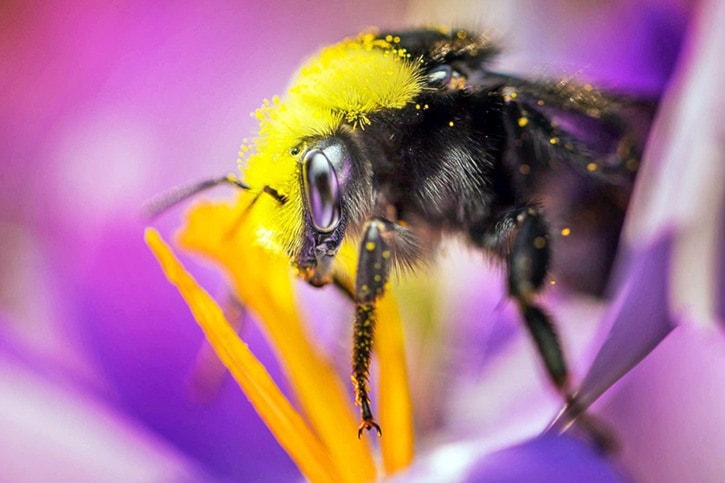To B.C. cranberry farmers some insects are pests that can damage their crops and cause economic damage, while others are beneficial, preying on the bothersome bugs or pollinating the fruit.
Regardless of their agenda Warren Wong sees them all as interesting subjects, capturing as many as he can through the glass of his macro lens.
And now a collection of his close-up photographs is showcased in the recently released Integrated Pest Management for Cranberries in Western Canada 2nd Edition 2015 (IPM guide).
 “Between my love for photography and insects, insects came first,” Wong said. “My interest in the insect behavioural ecology began from my studies at Simon Fraser University (SFU) and continued as I worked as a co-op student at Agriculture Agri-Food Canada (AAFC).”
“Between my love for photography and insects, insects came first,” Wong said. “My interest in the insect behavioural ecology began from my studies at Simon Fraser University (SFU) and continued as I worked as a co-op student at Agriculture Agri-Food Canada (AAFC).”
That’s where he met his supervisor, Dr. Sheila Fitzpatrick, a research scientist and entomologist at AAFC in Agassiz.
Fitzpatrick provided Wong with the tools and means to develop his photography skills, leading to the development of his role in the IPM guide that was released on Feb. 2 to coincide with the BC Cranberry Congress.
And while his photography is one of the key features in the guide, the images serve a greater purpose than just aesthetic pleasure for its readers.
“The images convey information about the insects: where they are found, what they look like up close, what sort of damage they do,” Fitzpatrick said. “The high-quality, high-resolution images that are printed in the IPM guide booklet attract the attention of the reader and enhance the transfer of information about the insects.”
She praises her student research assistant for his keen eye for detail, creative and artistic abilities and his patience with the technical aspects of the necessary camera work.
“Taken together, these qualities have helped him develop into an excellent photographer,” he said.
“His generous nature prompts him to share all aspects of the photographic process with others.”
Wong also assists Fitzpatrick with the field and lab aspects of her scientific research on behaviour, ecology and management of insect pests of berry crops.
The relationship between the science and photography came together for Wong a year after his first experience with a DSLR camera when experienced macro/bird photographer Sean McCann loaned him a Canon Rebel for a month.
Wong was hooked, but couldn’t afford a camera on his student budget.
When he started working with Fitzpatrick a year later they began work on the IPM guide concept in the fall of 2014.
As the lab acquired new photography equipment in preparation for the next field season, Wong took a four month photography course at Vancouver Photography Workshop (VPW).
“I returned to AAFC in May, and began hunting down a list of pests and their developmental stages throughout the season,” he said. “This was all made possible due to Sheila’s expertise in cranberry pests and her excellent relationship with consultants and growers throughout the Fraser Valley and Richmond.”
Fitzpatrick has been a research scientist with AAFC for 27 years, conducting studies on behaviour, ecology and management of insect pests of berry crops during that time.
“The cranberry-growing industry has received a lot of my research attention, because it is a proactive industry that is receptive to new research information about IPM,” she said.
And her new guide for cranberry integrated pest management means to build on that industry openness, helping farmers with their decision making and risk management processes.

IPM encompasses the “coordinated use of multiple suppressive tactics to manage pests that would otherwise cause economically significant damage,” according to Fitzpatrick.
If pests are detected, identified and monitored by growers in consultation with research professionals, the decision-making tools IPM provides can be used “to assess pest problems over time and apply management tactics only when economically significant damage is likely to occur.”
The trend in cranberry farming pest management since the publication of the first guide has been a phase-out of broad-spectrum organophosphate insecticides, which are higher in mammalian toxicity than the currently-allowed versions.
Those less toxic forms of insecticide are more specific in their actions and that’s where the new IPM guide comes in: a more detailed knowledge of pest identity is needed.
Fitzpatrick’s expertise is complemented in the study by Wong’s images to help farmers gain more precision themselves.
As for Wong (who is leaving Agassiz in April), he is grateful for the Agassiz community both online and off.
He met many photographers in the area through Facebook and enjoyed getting to know the people and places—and insects—of Agassiz Harrison.
“In research it takes effort to describe behaviour with words, but during my time in Agassiz, I hope I have developed the means to express their behaviour through photography.”
• To see the entire guide with Wong’s images, visit www.bccranberries.com/bccmc-ipm-booklet.html
